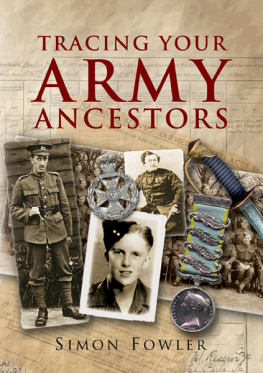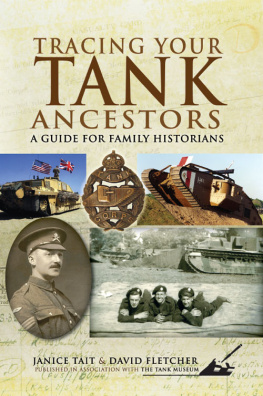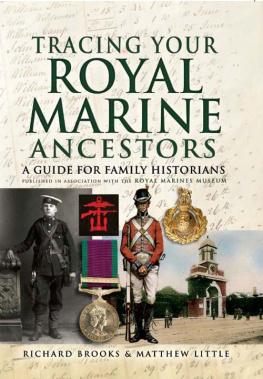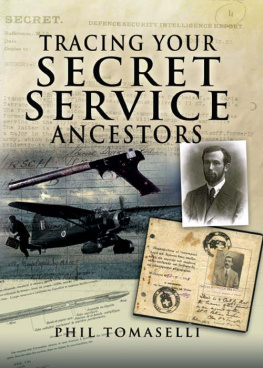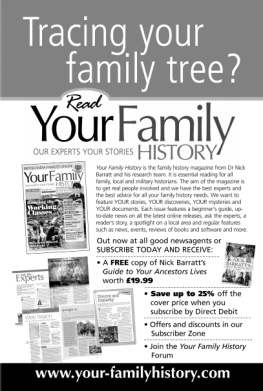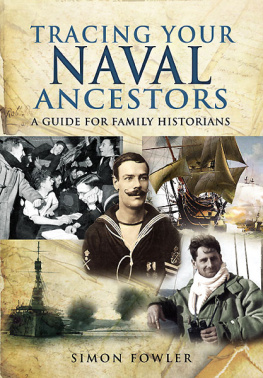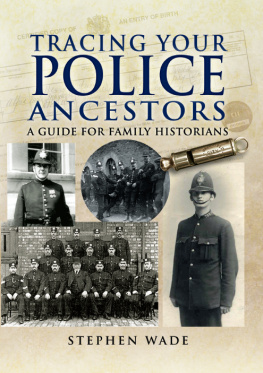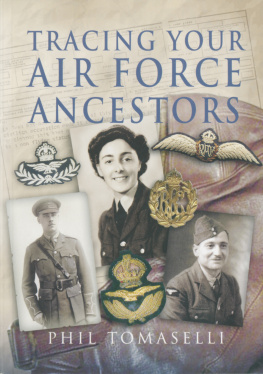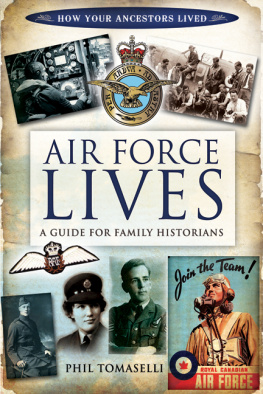TRACING YOUR
SERVICE WOMEN
ANCESTORS
FAMILY HISTORY FROM PEN&SWORD
Tracing Your Channel Islands Ancestors
Marie-Louise Backhurst
Tracing Your Pauper Ancestors
Robert Burlison
Tracing Your Yorkshire Ancestors
Rachel Bellerby
Tracing Your Royal Marine Ancestors
Richard Brooks and Matthew Little
Tracing Your Huguenot Ancestors
Kathy Chaters
Tracing Your Labour Movement Ancestors
Mark Crail
Tracing Your Army Ancestors
Simon Fowler
A Guide to Military History on the Internet
Simon Fowler
Tracing Your Northern Ancestors
Keith Gregson
Your Irish Ancestors
Ian Maxwell
Tracing Your Scottish Ancestors
Ian Maxwell
Tracing Your London Ancestors
Jonathan Oates
Tracing Your Tank Ancestors
Janice Tait and David Fletcher
Tracing Your Air Force Ancestors
Phil Tomaselli
Tracing Your Secret Service Ancestors
Phil Tomaselli
Tracing Your Criminal Ancestors
Stephen Wade
Tracing Your Police Ancestors
Stephen Wade
Tracing Your Jewish Ancestors
Rosemary Wenzerul
Fishing and Fishermen
Martin Wilcox
Tracing Your Canal Ancestors
Sue Wilkes

First published in Great Britain in 2012 by
PEN & SWORD FAMILY HISTORY
an imprint of
Pen & Sword Books Ltd
47 Church Street
Barnsley
South Yorkshire
S70 2AS
Copyright Mary Ingham 2012
ISBN 978 1 84884 173 4
Digital Edition ISBN: 978 1 84468 279 9
The right of Mary Ingham to be identified as Author of this Work has been asserted by her in accordance with the Copyright, Designs and Patents Act 1988.
A CIP catalogue record for this book is
available from the British Library.
All rights reserved. No part of this book may be reproduced or transmitted in any form or by any means, electronic or mechanical including photocopying, recording or by any information storage and retrieval system, without permission from the Publisher in writing.
Typeset in Palatino and Optima by
Phoenix Typesetting, Auldgirth, Dumfriesshire
Printed and bound in England by
CPI UK
Pen & Sword Books Ltd incorporates the imprints of
Pen & Sword Aviation, Pen & Sword Family History, Pen & Sword Maritime, Pen & Sword Military, Pen & Sword Discovery, Wharncliffe Local History, Wharncliffe True Crime, Wharncliffe Transport, Pen & Sword Select, Pen & Sword Military Classics, Leo Cooper, The Praetorian Press, Remember When, Seaforth Publishing and Frontline Publishing
For a complete list of Pen & Sword titles please contact
PEN & SWORD BOOKS LIMITED
47 Church Street, Barnsley, South Yorkshire, S70 2AS, England
E-mail:
Website: www.pen-and-sword.co.uk
ACKNOWLEDGEMENTS
I am most grateful to the staff of the archives, libraries and museums mentioned in this book. They kindly gave their time and took trouble to answer my questions, source photographs, etc. I am particularly indebted to Sarah Paterson at the Imperial War Museum and Julia Massey at the Queen Alexandras Royal Naval Nursing Service archive. Any errors and omissions are my own.
As well as giving encouragement and support, Peter White most generously granted access to his impressive photographic postcard collection, bringing to life the women described in these pages. Paul Whites continued interest, Debbie Beaviss valuable input and Alison Miless careful attention to detail were much appreciated.
I am grateful to Simon Fowler and Rupert Harding at Pen & Sword for their patient encouragement, and to David Lister for his stoic support.
Illustrations that are not otherwise credited are part of my own collection.
PREFACE
M ilitary service records open a fascinating window on the lives of our ancestors through documentary sources that would otherwise never have been preserved.
Since the nineteenth century, women have increasingly worked alongside the armed services. Tens of thousands served in the First World War, pioneering new roles and overturning prejudices about womens physical and mental capacities.
Most guides to tracing service ancestors offer only a brief section on the women. This book attempts, within the space constraints of covering so many different services, to remedy that. It is dedicated to my Great Aunt Lizzie (Betsy Elizabeth), in search of whom I began exploring nursing service records nearly twenty years ago. Sadly, she still eludes me, but my search for her uncovered many other peoples great aunts, grandmothers and great-grandmothers who engaged my interest, enthusiasm and admiration. Without her, and certainly without them, this book wouldnt have been written.
I hope it will help you find the woman you are researching, whether she is a blood or a spiritual ancestor. It should help you to learn more about the part women have played in recent history; I have certainly learnt a lot researching it.
If this is your first foray into family history research, it may be useful to read the section of the Introduction headed Getting Started.
INTRODUCTION
T his guide aims to help you research women who worked alongside the armed forces from the 1850s to the 1920s, the main period for which records are currently in the public domain. Some earlier naval nursing records are mentioned. Crimea nurses are included and the Boer War is covered. The main focus, however, is on the First World War, when tens of thousands of ordinary women pioneered the womens auxiliary services, driving lorries and taking on mens semi-skilled technical jobs, as well as the more traditional womens work of catering, cleaning and nursing the sick and wounded.
Structure of the Book
It seemed only right to begin with the first official body of women employed by the armed services army schoolmistresses. The chapters are otherwise divided into two main sections, the first covering medical services of the army, navy and air force. This section begins with army nursing, arranged chronologically. An explanation of the organization of army hospital care precedes the chapters on the First World War, which include army nurses, Voluntary Aid Detachment (VAD) members, masseuses, the First Aid Nursing Yeomanry (FANY), women doctors employed by the armed forces and the Royal Air Force nursing service, followed by a short section on Queen Alexandras Military Families Nursing Service (QAMFNS). The final chapters in this section cover the naval and Indian army nursing services.
The second section includes the womens auxiliary services set up in the First World War, and their precursors, the Army Pay Department (APD) and the Womens Legion (WL). The Womens Forage Corps (WFC) and the Womens Land Army (WLA) are covered more briefly. The latter was purely an army in name, only linked with the armed services through its association with the Womens Forage Corps, but it seemed wrong to leave it out.
Encompassing so many services has inevitably limited what I have been able to include, but I have offered suggestions for further reading on most services. A key to abbreviations will be found at the end of the book. The history and organization of each service are described, together with what life was like, uniforms worn, casualties suffered and a section titled recognition of service. Research sources are listed under headings according to where they are held, with some examples of what may be found.


